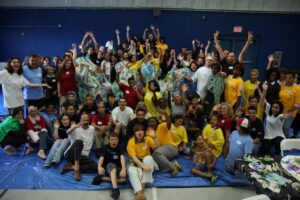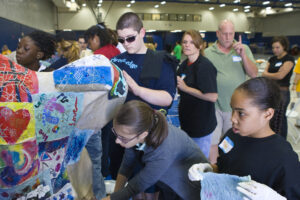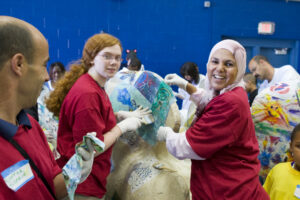
The Collaborative Art Initiative (CAI) brings together teachers, youth leaders, and young people from three continents in the spirit of artistic expression to create sacred public spaces where mindful interaction, open dialogue, and collaboration become possible and tangible.
The CAI is a dynamic, two-phase educational and cultural exchange program of the University of the Middle East Project (UME), which took place during 2008 in the U.S. and will take place during 2009 in Morocco. In combination, the various elements of the program seek to capture the sense of sacredness in different spaces, the gift of the arts to humanity, and the feelings of freedom, bewilderment, change, and progress that creativity brings to individuals and communities. During all phases, the program includes a blend of classroom hours, creative practica, cultural activities, and visits to community sites and institutions, including art galleries, parks, youth centers, and sacred and historical sites. In sum, all of these aspects contribute to a cohesive learning experience.
During the first phase of the program, which took place in July 2008, 26 educators and numerous students from diverse communities throughout the Middle East, North Africa and the United States convened at Roger Williams University in Bristol, RI. During this two-and-a-half-week segment, participants explored topics related to fostering creativity through the arts, integrating education across disciplines, and promoting cooperation for more inclusive communities. As with all UME programs, the CAI bridged theory and practice through a variety of seminars and activities designed to model the ways in which creativity and the arts enrich our lives on every level, as well as to demonstrate their value to building inclusive communities that celebrate diversity and self-expression.

The highlight of this phase of the program was the co-creation of a large-scale collaborative sculpture (10 ft x 8 ft x 9 feet) by CAI participants and over 60 youth from diverse communities in the Rhode Island area. This impressive event was covered by the Providence Journal and the resulting sculpture is on permanent display on the Roger Williams University campus. Drawn out, debated, layered, sealed and delivered through dialogue and collaboration, the sculptural installation serves as a permanent commemoration of the participants’ experience together, and as an interactive inspiration to others. Through the program, participants gained the essential skills and teaching methodologies to replicate the collaborative art process in their own schools and communities.

In the spring of 2009, UME will reverse the flow of the exchange and provide the opportunity for ten American educators to work with youth in Morocco, thereby furthering the collaboration between the US and MENA region. The experience provided by the travel and exchange throughout the Initiative stands to deepen participants’ understanding of the global needs and challenges associated with actively creating a world that is collectively imagined.
 A dynamic, cross-cultural energy infuses the creative and learning processes during the CAI. This way of thinking, working, and relating to one another embodies the spirit and philosophy of all UME academic programs; it is a vision of critical engagement in classrooms and communities that combines practice with theory, learning with doing, reflecting with growing. To this, the CAI adds a fresh artistic component that carries the program into new possibilities.
A dynamic, cross-cultural energy infuses the creative and learning processes during the CAI. This way of thinking, working, and relating to one another embodies the spirit and philosophy of all UME academic programs; it is a vision of critical engagement in classrooms and communities that combines practice with theory, learning with doing, reflecting with growing. To this, the CAI adds a fresh artistic component that carries the program into new possibilities.
The CAI built on the courses of Professor Mark Cooper, who has taught the core principles of his book, Making Art Together to the participants of UME’s Teacher Education Institute (TEI) in Boston, MA, during the 2006 and 2007 institutes. These classes, which highlight collaborative and deliberative processes and produce profound and meaningful art works, have been one of the highlights of the TEI. Following the TEI in 2006, the participants’ sculpture was displayed at the 511 Gallery in the Chelsea neighborhood of New York City, as well as the Middle East Studies (MESA) conference at Harvard University. Numerous TEI participants from the Middle East and North Africa have also recreated the collaborative art process with their students in their home communities.
Program Summary
 |  |  |  |
This program was primarily funded by the Bureau of Educational and Cultural Affairs at the United States Department of State.

he University of the Middle East Project (UME) builds bridges through education among societies and cultures in the Middle East, North Africa, North America and Europe.